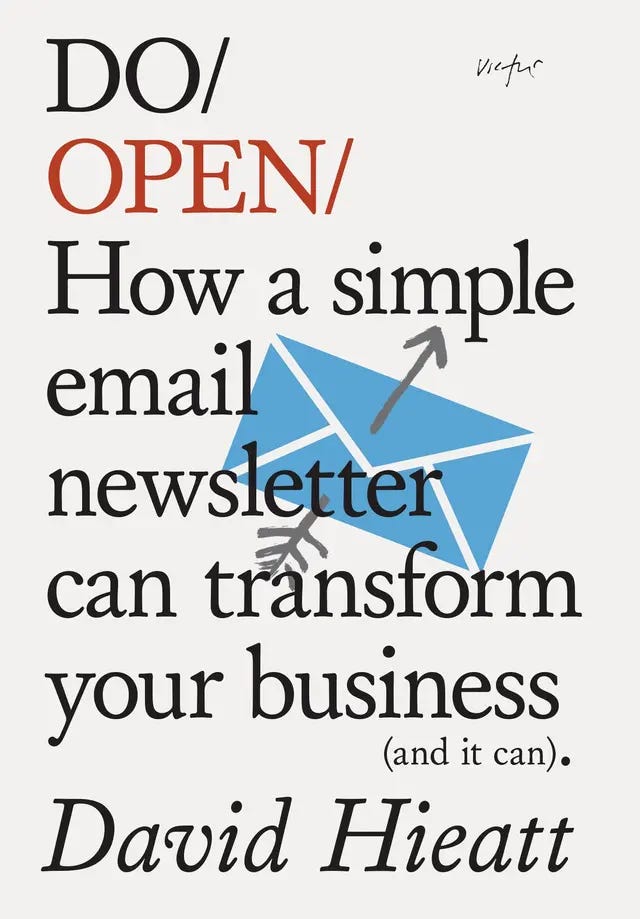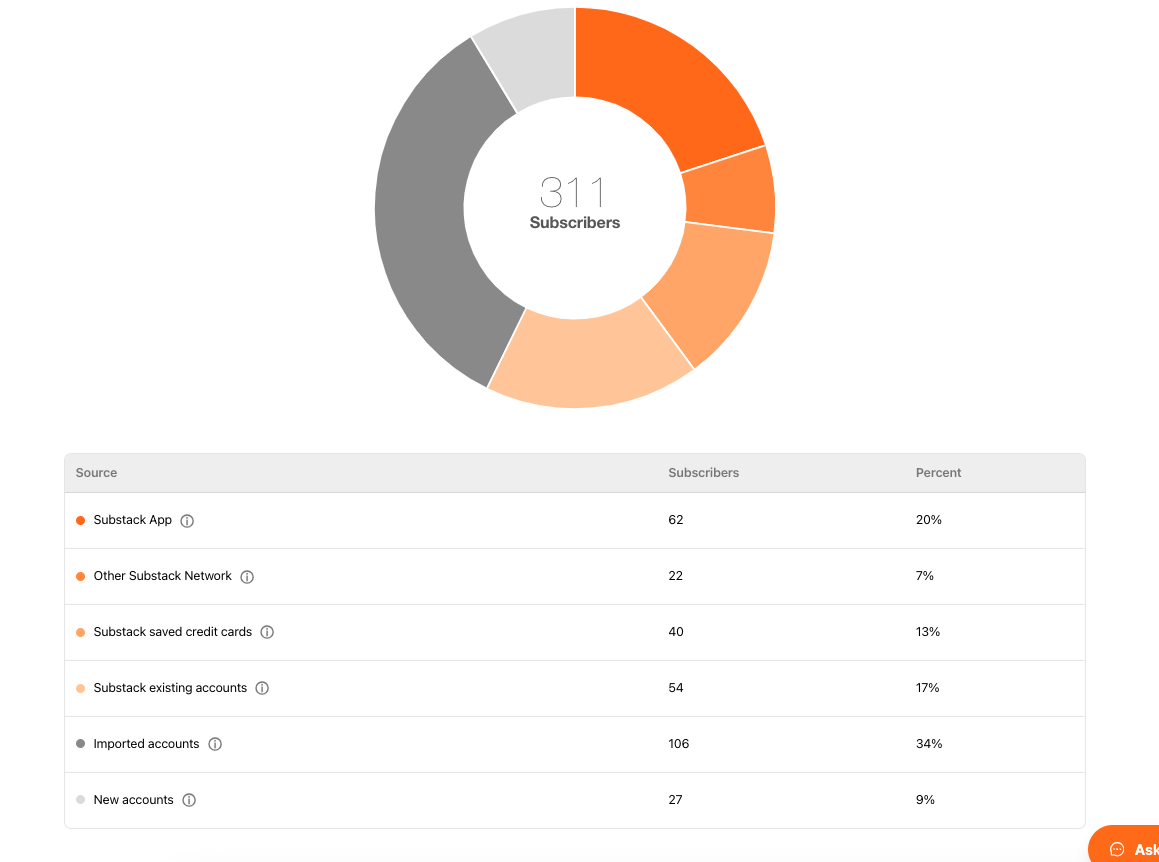Borrow everything I know about growing a newsletter
My takeaways from growing to 300+ paid subscribers in six months on Substack
Hiya 🌊! I’m Lucy from Hype Yourself. I chat about self-promotion and creative living to earn an income from your expertise or passion. Today’s article is a seasonal bonus 🎁, as several of my audience requested the topic.
Note: Some of my opinions go against typical Substack advice but worked for me.
With any advice, one-size-fits-no-one.
Take the bits that work for you and put your signature on it.
I started my newsletter in 2019 when I attended a workshop by David Hieatt. This book accompanies the syllabus. I highly recommend it.
I arrived on Substack in October 2023 with just under 5,000 subscribers by following what I learnt from that course and experimenting a lot. I had what some call a leg-up. I would call it four years of hard work, but you know, horses for courses.
Understand who you are and what you are about
Understand the importance of branding. You are your own brand. You have a choice to make it obvious to others if you are for them. People don’t choose you on price; they choose you for you. The best thing you can do is be clear about who you are and what you are for.
Know your values: Write down all the values that apply to you and your writing. Then, pick 3-5 that apply. These are your guardrails. I’ve seen some curious collaborations, which I can only assume are ego-led.
Images: We love them. They break up our writing and look excellent on thumbnails. There is a reason magazines and newspapers have picture desks. I use Adobe Express to edit many of my images into brand colours, and they also have great stock imagery. Unsplash is great, but a lot of you use the same photography OR completely different styles throughout, which makes it hard for you to have a signature look and be memorable.
Don’t over-egg the emotional side: I don’t want anyone to be emotionally guilt-tripped into buying from me. For those new here, I will talk about the fact that this is a new gamble for me, and I’m hoping that one day I can replace my agency salary. Occasionally, I talk about the personal reasons why I want to work flexibly, but this is not my lead sales message. I want you to buy from me so I can help you hype yourself.
Practice in public
Turn on paid immediately. This was advice I took from a free workshop by
as I already had an audience, I got to share with them what I was doing and invite them to come with me at a pilot priceExplain you are a beginner: Substack and many other email newsletter platforms can be confusing when starting. Tell people you are a beginner and that you are learning.
Try out different content: What feels good to you? What sort of writing do you want to experiment with? Are you writing a personal essay, a listicle, or a deep-dive investigative post?
You don’t need a back catalogue: Most people will not be looking at your homepage as much as you are. If you are starting, you don’t need to have a load of content on there.
Set out your stool: This is for you as much as it is for your audience. What can they expect from you? What can you expect from yourself? It’s okay if you are still playing with this, but at least give them a general idea.
Start….something like “I’m new here and will talk about this if you are coming along”.
did a fabulous one you can view here:
Who are you writing for?
Argument to write only what you want: The only people I have seen do this are already “celebrity writers.” I’m not saying it’s impossible to make your writing a success by only writing what you want, but I think it takes a lot more graft to do that.
Argument to write what others want: If you only write for others, you will have your creative energy sucked out. It is always good to get an idea from your audience of what they like and are interested in. My best posts or advice articles are what I need to write or what I know my audience needs - not what I’m asked for.
Create an editorial schedule.
Cadence: I recommend creating a basic editorial schedule. Aka - a list of what you will talk about and when. Why?
You don’t run out of ideas
Write down any requests you get in
Mix up your styles and space them out, aka personal essay one week and listicle another.
Decide on a posting frequency and stick to it. (Note: You don’t need to let your audience know every time you change your cadence).
Guest collaborators: Do you know them? Do their values align? Don’t get stuck with someone in your newsletter who becomes a slippery fish later. How many do you want? Your editorial schedule will help so you don’t say YES willy-nilly.
Writing for other people: Don’t let your ego trick you into thinking you only need to write for people with large audiences. Even if the potential guest has less than 100 subscribers, if that audience is a direct match, think about being sat in a room with 100 of your perfect customers. That is a lot. Don’t overcommit, though.
Realistically, how many guest posts can you do?
Very unpopular things I’ve done that have worked well
Instagram. There was an Instagram bashing phase on Substack where everyone was leaving to huge fanfare.
The re-appearance of these writers back on Instagram was done silently 🤔.
From the start, I dug my heels in on this momentum because I grew my first 100 paid subscribers by promoting on Instagram daily.
Over a third of my audience has come from outside the platform.
If we combine imported and new accounts, that is nearly 43% of my paid subscriber list.
I'm not focused heavily on Substack: I’ve either received or read advice that tells you to play on Notes and comment on many other people's articles and threads.
I’m on maternity leave, so my time is limited - although I hear it works well for others.
But, I instead focused on growing outside of Substack, where I already have relationships.
This has made the conversion to paid easier because they already know me, and the retention rate is higher than those inside Substack.
(As an aside: the people who I see rely solely on the platform are the ones bitten more by comparisonitis and find it a less joyful place🤷🏻♀️)
Aggressively growing my free community as much as my paid: I was told to focus only on increasing paid subscribers because the free will come.
I didn’t take it 🙆🏻♀️ . Maybe I’m bananas but I think it is nuts to focus only on growing paid rather than growing in general.I’m interested in helping as many people as possible to hype themselves.
For those who want my best advice and access to me, they have to pay.
People need to get to know you first, and being a free subscriber is an amazing way to do this.A free subscriber might not want to pay for my newsletter but might buy other things from me.
Riding through the dips: My numbers are not always going up in the green.
They have, of course, dipped or slowed.I don’t kneejerk into a heavy discount; in my opinion, it not only lowers the quality of my writing, but it also disrespects those who joined me on the pilot price and pulls other writers down. If anything, my price will steadily increase.
Tactics to grow:
Recommendations: Substack makes it easy to grow by encouraging you to recommend other publications and vice versa. This is a great way to increase your free list.
Create a gift: One of my most popular pieces was a Borrow my nonfiction blueprint, the marketing equivalent of a ‘lead magnet'. Many writers on this platform struggle to launch books, so I wanted to make it a freebie to introduce my work to new people.
Sit tight: Everyone seems to be in a rush to grow. I’m distinctly average (on any platform) but unreasonably consistent. That is how I grow above and beyond any other trick. I just keep posting my weekly email, offering my monthly live and offer the occasional gift.
Support the new and the small: You know who does need help to hype themselves and whose day will be made if you share their writing?
1. People who are new to writing a newsletter and
2. People with a smaller subscriber listI vote for championing the underdogs by supporting smaller and new writers over bigger names.
Don’t be desperate: There seems to be a trend of always calling out big-name writers, which can feel a bit grabby. There are thousands of writers here; surely you can give an example of someone else? And look, even if a big name does restack you, it’s not going to turn you into a six-figure writer.
Also the cold recommendation for a recommendation requests 🤮. Enough said.
Business outside of your newsletter:
What do you sell? We would all love to have thousands of paid subscribers for just one email a week, but life does not work like that for the vast majority of us.
If and when I need to, I have at least ten other revenue streams to fall back on. More about these in this piece.
You can buy my books Hype Yourself or Brand Yourself.
You can book me for a one-to-one mentoring session.
You can book me to speak or host a workshop for your university, accelerator membership or in-house team.
I’m also an Adobe Express global ambassador and Domestika instructor.
Any more for any more? As a seasonal treat, questions and comments are open to all.
Keep on hyping.
Lucy x


















Amazing advice! I love what you say about not having an agressive strategy around paid subscription. I decided to stay free because adding a paid subscription would cause too much self inflicted pressure. Thanks for sharing this for free x
Thank you for this piece. I'm early stage in my newsletter in the area of chronic pain and so appreciate your advice to promote outside the platform. I want to hype my work on this and see your strategies as valuable and actionable. TY!